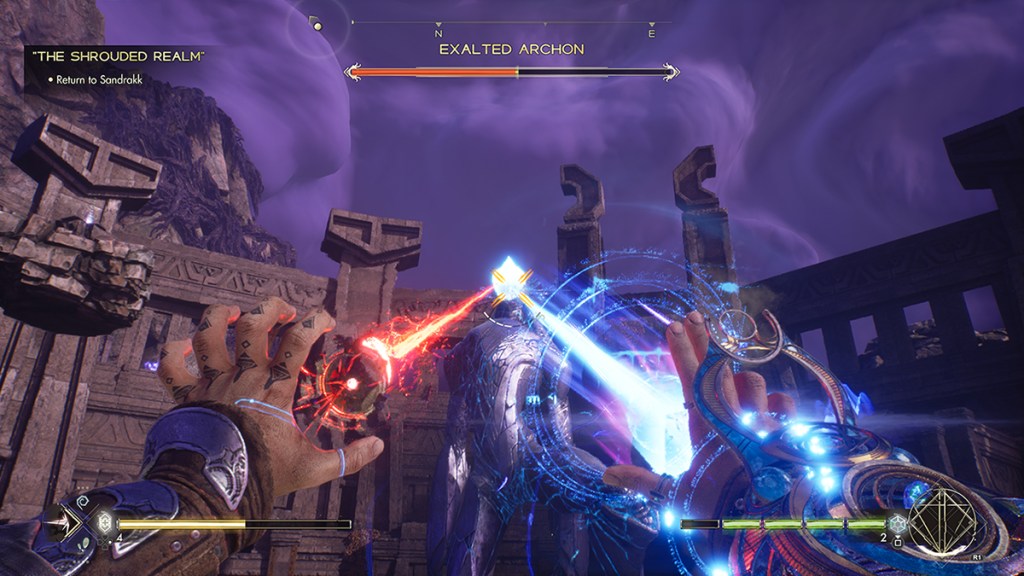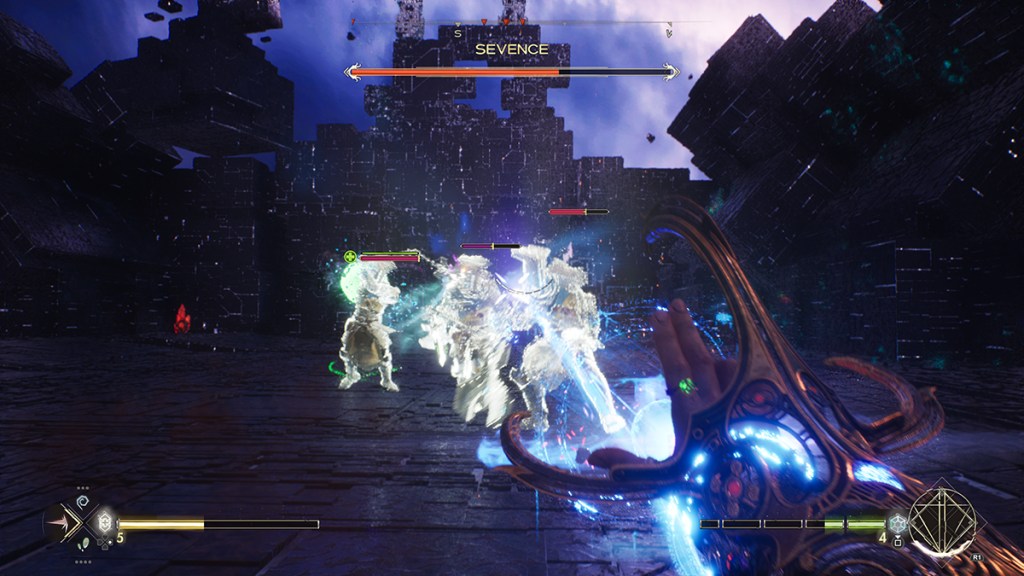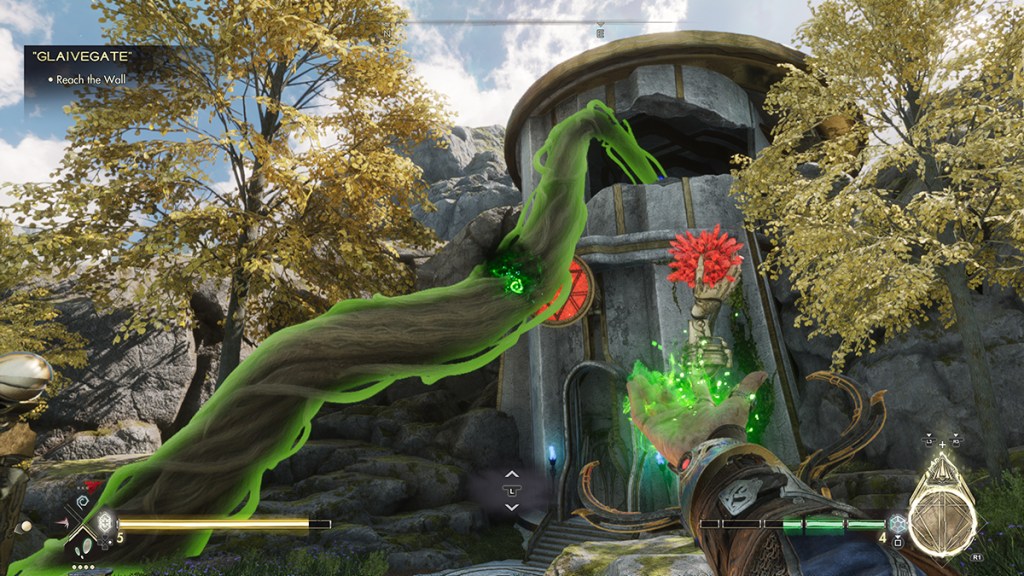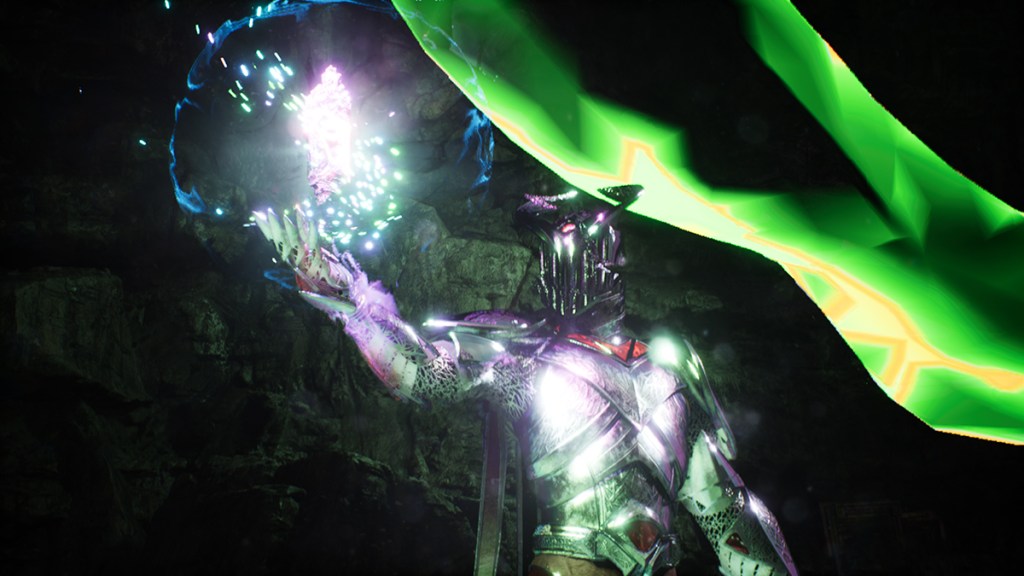The single-player first-person shooter has become somewhat of a lost art. Risky trends have pushed the genre into multiplayer territory where they all fight to the death to be the last one standing. It’s a battle royale of battle royales. Bethesda Softworks has been almost the sole arbiter of the bigger budget solo shooter, a club that Ascendant Studios is joining with its first title, Immortals of Aveum. Trading AK-47s for mystical gauntlets has not forfeited its identity as a first-person shooter, as this clever swap has allowed it to become one of the freshest debuts the genre has seen.
Aveum has some DNA from other shooters — the persistent mission marker is right out of Call of Duty — but it’s able to stand out because of its unique approach to combat. Being a rare spellcaster called a triarch, players have access to three weapon colors at all times. Blue spells are focused on precision, green spells generally have a high fire rate, and red spells are all about concentrated bursts of damage. Each class also has three variants that put their own spin on those core tenets and the gear system adds even further variation, but this streamlined color-coding ensures that it’s easy to discern what each weapon does in the midst of battle.

Being easy to read and having responsive controls is the foundation Aveum uses to support its more refined systems. Players gradually get access to six devastating special spells called Furies that are crucial in dealing big damage and setting up for deadly combos. The generous supply of consumable mana crystals encourages players to use them liberally and being given that freedom to let loose makes combat more exciting.
Control spells are support tools that can lasso enemies in, slow them down, or, if timed well, interrupt their spellcasting. They can be easy to neglect at first since they aren’t directly about dealing damage, but they offer advantages that become crucial in the harder fights. The Dominion spell is the complete opposite since it lets players blast out a devastating beam once the associated meter fills up, which makes for a cathartic way atomize the opposition.

Dashing, hovering, and a shield spell give players the capability to avoid damage as easily as they can dish it out. Hovering gives greater maneuverability and air superiority, but the dash and shield are more interesting because of how they play off one another.
The five-second cooldown on the dash is off-putting at first since it’s so far outside of the genre’s norms of being able to dodge constantly. The shield also breaks after a few shots, limits players to their base spells, and can only stop incoming fire from the front. Neither can get the job done, but that’s the whole point. Analyzing what defensive tool is best for the situation is just yet another wrinkle that gets players to actively think about their situation and react accordingly.
It’s a lot to juggle, but it all only makes Aveum a more engaging shooter that’s not just about holding down the trigger until everyone explodes. Choice defines its action since there are always multiple ways to reign down on the opposition, and its hordes of unique and resilient enemies mean that players can’t just mindlessly rely on the same handful of offensive or defensive tactics to survive.
Its wide arsenal and smooth controls invite players to indulge in everything it has to offer and fulfill the fantasy of becoming an all-powerful battlemage. Sometimes it’s an explosive show of domination against an army, while other times it’s a tense one-on-one duel. It’s gratifying either way, especially when it’s set to the hip-hop-infused soundtrack that uses fast 808 drums and hit hats to pump up the tempo. Even its vast array of upgrades meaningfully change combat by adding unique perks, further showing how thoroughly each of its systems was designed.

Aveum’s combat is fantastic enough to carry the experience, but its other gameplay pillars play their supporting role well. Puzzles intuitively use the same tools as combat and offer interesting brain teasers that test the player’s spatial awareness and perception. They strike that perfect balance by never being insultingly easy or pointlessly difficult and provide a solid break from the action.
Its array of movement abilities don’t turn Aveum into a parkour game, but do mean its levels can be less linear and hide more upgrades and gear. The layouts are wide enough to give players plenty of room to explore, yet also straightforward enough to avoid needless bloat. Both provide balance to the aggressive combat, and are also balanced enough in and of themselves by never overstaying their welcome.

The narrative is also remarkable in how it balances its many threads, despite the outward appearance of a rote tale where good conquers evil. Aveum ropes in themes of classism, how authority should be questioned, and the effectiveness of propaganda to ground its fantasy setting into something more believable. While it only flirts with more radical solutions that would have made the narrative truly ascend, its ability to approach these ideas at all is admirable and only results in a more believable world.
Its cast is similarly complicated, and the game shines a light on all of its characters and examines the good and the bad of its main players regardless of their affiliation. Leaders or groups who are positioned as altruistic can hide terrible secrets that call their legacies into question. Jak, the main character, often makes foolish mistakes and, despite his noble intentions, is often berated for his brashness or incompetence. Even the main antagonist Sandrakk — who looks like a villain from a Zack Snyder movie — makes salient points and is much more nuanced than the delusional tyrant he appears to be.
Its story, while sometimes using magical jargon as a crutch, ties these many disparate characters and ideas together pretty well. Effective foreshadowing and its ability to consistently introduce new variables keeps it from becoming a predictable, MacGuffin-filled slog interspersed with extravagant magic battles. And even though the modern lingo doesn’t always work and there are some questionable lines here and there, examining each of the core characters makes them strong enough avatars to shepherd the plot to its well-earned conclusion.

The land of Aveum is also a beautiful setting at times with its serene vistas and larger-than-life titans, but there’s a softness to its visuals that is hard to shake. A decent portion of the game outside of cutscenes can look a little fuzzy, which robs Aveum of the sharpness it deserves. It mostly runs at a decent frame rate, but it seems like the visuals were noticeably scaled down in an effort to prioritize the gameplay. It’s likely the right call since much of Aveum’s combat is dependent on its responsiveness. However, that doesn’t fully absolve it since some of this fuzziness makes it difficult to pick out targets in the background during firefights.
Immortals of Aveum Review: The final verdict
Even with inconsistent visuals, Immortals of Aveum is an enrapturing experience. Its combat gives players a stunning amount of choices and emboldens them to become the ultimate murderous magnus. The narrative doesn’t give into the most bland fantasy clichés, either, and instead tells a well-constructed tale with flawed characters that are given the space to grow. It’s a magical first effort from Ascendant that has set the stage to grow into a spellbinding series.
-
Combat is responsive and full different options
-
Upgrades are doled out well and meaningfully change combat
-
Story touches on important themes and has multiple threads that weave together well
-
Unique, hip hop-inspired soundtrack adds energy to firefights
-
Visuals, while generally pretty, can look a bit soft
Disclaimer: This Immortals of Aveum review is based on a PS5 copy provided by the publisher. Reviewed on version 1.001.000.





